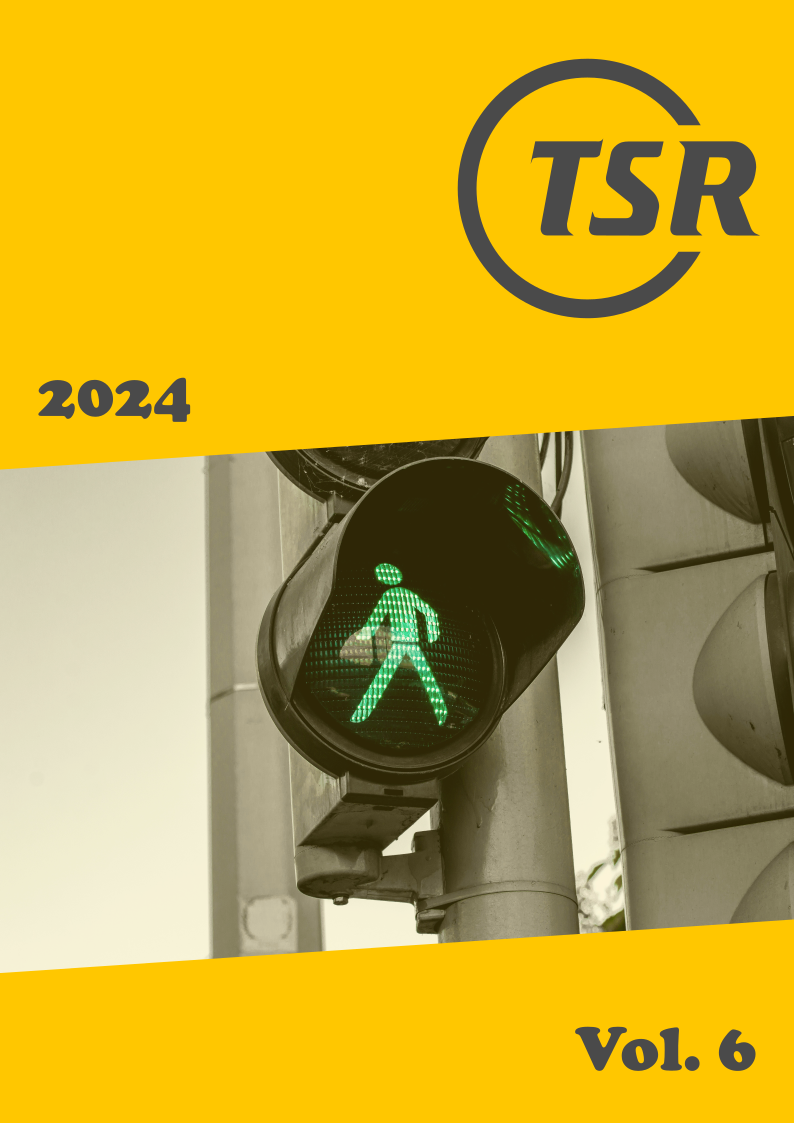Bicycling tasks relation to stability measures during alcohol intoxication
DOI:
https://doi.org/10.55329/ymam9256Keywords:
alcohol intoxication, roll rate, stability, yaw rateAbstract
Bicycling accidents are a major traffic safety problem and are deemed ‘an unacceptable human and social price for EU citizens’. One of the major causes for bicycling accidents is loss of balance. A related influencing factor is alcohol intoxication. It is a primary, long term, safety objective to develop safety systems for the cyclist. The present work aimed to understand how to measure cyclists’ instability via steering and leaning inputs, while considering that steering and leaning might vary depending on the cycling task being performed. Of 28 participants, 19 were given doses of alcohol up to 1.0‰ and 9 remained sober (control group). Breath alcohol concentration was measured. The participants repeated the cycling test track session five times (with each block lasting 35 minutes). The track session contained three different tasks: cycling slalom, straight, and slowly. Speed, yaw rate, and roll rate were assessed continuously. Yaw rate and roll rate were relatively sensitive for the different cycling tasks. The threshold level of the angular velocity measurements was related to the cycling task performed. Alcohol intoxication at 0.7‰ had a significant impact on performance. The rather simple measurements used can detect instability. Instability should be measured differently depending on the cycling task performed. The study represents a small step towards a safety system for cyclists.
Downloads
References
Adminaité-Fodor, D., G. Jost (2020), 'How safe is walking and cycling in Europe?', European Transport Safety Council, PIN Flash Report 38.
Alizadehsaravi, L., J. K. Moore (2023), 'Bicycle balance assist system reduces roll and steering motion for young and older bicyclists during real-life safety challenges', PeerJ, 11, e16206. DOI: https://doi.org/10.7717/peerj.16206
Alkompassen, (2019), 'Promilleräknare - Räkna ut promille [Blood alcohol calculator - Calculate blood alcohol level]'.
Andersson, J., C. Patten, H. Wallén Warner, C. Andersérs, C. Ahlström, R. Ceci, L. Jakobsson (2023), 'Bicycling during alcohol intoxication', Traffic Safety Research, 4, 000028. DOI: https://doi.org/10.55329/prpa1909
Berk, T., S. Halvachizadeh, J. Backup, Y. Kalbas, T. Rauer, R. Zettl, H. C. Pape, F. Hess, J. E. Welter (2022), 'Increased injury severity and hospitalization rates following crashes with e-bikes versus conventional bicycles: an observational cohort study from a regional level II trauma center in Switzerland', Patient Safety in Surgery, 16(1). DOI: https://doi.org/10.1186/s13037-022-00318-9
Cain, S. M., J. A. Ashton-Miller, N. C. Perkins (2016), 'On the skill of balancing while riding a bicycle', PLoS ONE, 11(2), 1–18. DOI: https://doi.org/10.1371/journal.pone.0149340
de Waard, D., S. Houwing, B. Lewis-Evans, D. Twisk, K. Brookhuis (2016), 'Bicycling under the influence of alcohol', Transportation Research Part F: Traffic Psychology and Behaviour, 41(Part B), 302–308. DOI: https://doi.org/10.1016/j.trf.2015.03.003
Drägerwerk, (2017), 'Dräger Alcotest® 6820 med: Alcohol screening device'.
EC, (2020), 'Next steps towards “Vision Zero”: EU road safety policy framework 2021-2030', European Commission, Directorate-General for Mobility and Transport.
Edelmann, J., M. Haudum, M. Plöchl (2015), 'Bicycle rider control modelling for path tracking', IFAC-PapersOnLine, 48(1), 55–60. DOI: https://doi.org/10.1016/j.ifacol.2015.05.070
Hartung, B., N. Mindiashvili, R. Maatz, H. Schwender, E. H. Roth, S. Ritz-Timme, J. Moody, A. Malczyk, T. Daldrup (2015), 'Regarding the fitness to ride a bicycle under the acute influence of alcohol', International Journal of Legal Medicine, 129(3), 471–480. DOI: https://doi.org/10.1007/s00414-014-1104-z
Huertas-Leyva, P., M. Dozza, N. Baldanzini (2018), 'E-bikers’ braking behavior: Results from a naturalistic cycling study', Traffic Injury Prevention, 20(sup3), 62–67. DOI: https://doi.org/10.1080/15389588.2019.1643015
Juric, A., A. Fijacko, L. Bakulic, T. Orešic, I. Gmajnicki (2018), 'Evaluation of breath alcohol analysers by comparison of breath and blood alcohol concentrations', Archives of Industrial Hygiene and Toxicology, 69(1), 69–76. DOI: https://doi.org/10.2478/aiht-2018-69-3064
Lefarth, T. L., H. P. A. M. Poos, C. Juhra, K. W. Wendt, O. Pieske (2021), 'Pedelec users get more severely injured compared to conventional cyclists', Unfallchirurg, 124(12), 1000–1006. DOI: https://doi.org/10.1007/s00113-021-00976-x
Modig, F., M. Patel, M. Magnusson, P. A. Fransson (2012), 'Study II: Mechanoreceptive sensation is of increased importance for human postural control under alcohol intoxication', Gait & Posture, 35(3), 419–427. DOI: https://doi.org/10.1016/j.gaitpost.2011.11.001
Moore, J. K. (2012), 'Human Control of a Bicycle', PhD thesis, University of California, Davis, CA, USA.
Moore, J. K., M. Hubbard, A. L. Schwab, J. D. G. Kooijman, D. L. Peterson (2010), 'Statistics of bicycle rider motion', Procedia Engineering, 2(2), 2937–2942. DOI: https://doi.org/10.1016/j.proeng.2010.04.091
MSB, (2013), 'Skadade cyklister: En analys av skadeutvecklingen över tid [Injured cyclists: An analysis of injury trends over time]', Myndigheten för samhällsskydd och beredskap, MSB579.
Rekilä, K.-P., A. Klein-Paste (2016), 'Measuring bicycle braking friction in winter conditions', Cold Regions Science and Technology, 125, 108–116. DOI: https://doi.org/10.1016/j.coldregions.2016.02.005
Rizzi, M. C., M. Rizzi, A. Kullgren, B. Algurén (2020), 'The potential of different countermeasures to prevent injuries with high risk of health loss among bicyclists in Sweden', Traffic Injury Prevention, 21(3), 215–221. DOI: https://doi.org/10.1080/15389588.2020.1730827
Schwab, A. L., J. P. Meijaard, J. D. G. Kooijman (2012), 'Lateral dynamics of a bicycle with a passive rider model: Stability and controllability', Vehicle System Dynamics, 50(8), 1209–1224. DOI: https://doi.org/10.1080/00423114.2011.610898
Twisk, D. A. M., S. Platteel, G. R. Lovegrove (2017), 'An experiment on rider stability while mounting: Comparing middle-aged and elderly cyclists on pedelecs and conventional bicycles', Accident Analysis & Prevention, 105, 109–116. DOI: https://doi.org/10.1016/j.aap.2017.01.004
Utriainen, R., S. O'Hern, M. Pöllänen (2022), 'Review on single-bicycle crashes in the recent scientific literature', Transport Reviews, 43(2), 159–177. DOI: https://doi.org/10.1080/01441647.2022.2055674
Zuckerman, M., S. B. Eysenck, H. J. Eysenck (1978), 'Sensation seeking in England and America: Cross-cultural, age, and sex comparisons', Journal of Consulting and Clinical Psychology, 46(1), 139–149. DOI: https://doi.org/10.1037//0022-006X.46.1.139
Published
How to Cite
Issue
Section
License
Copyright (c) 2024 Jan Andersson, Henriette Wallén Warner, Peter Andrén

This work is licensed under a Creative Commons Attribution 4.0 International License.
Funding data
-
Trafikverket
Grant numbers TRV 2020/112351










